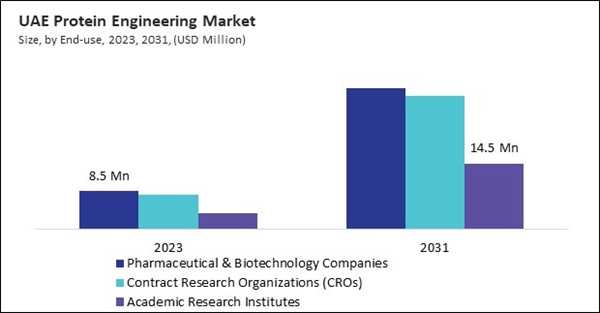The Brazil market dominated the LAMEA Protein Engineering Market by Country in 2023, and would continue to be a dominant market till 2031; thereby, achieving a market value of $144.1 million by 2031. The Argentina market is showcasing a CAGR of 19.7% during (2024 - 2031). Additionally, The UAE market would register a CAGR of 18.5% during (2024 - 2031).
Environmental biotechnology is another area where this engineering is making significant strides. The ability to engineer proteins and microorganisms to degrade pollutants and detoxify contaminated environments holds great promise for bioremediation efforts. For example, engineered bacteria capable of breaking down hydrocarbons in oil spills or converting toxic heavy metals into less harmful forms are being developed to address environmental pollution more effectively.
Agriculture, too, is benefiting from the advancements in the engineering. Developing genetically modified crops with improved traits, such as enhanced resistance to pests and diseases, increased nutritional content, and tolerance to abiotic stresses, is transforming modern agriculture. Engineered proteins play a crucial role in these advancements by enabling the precise modification of plant genomes to achieve desired traits.
In Brazil, the demand for this engineering is growing due to the country's large aging population, increasing the burden of chronic diseases. This demographic shift is contributing to a higher prevalence of age-related chronic conditions such as cancer, diabetes, and cardiovascular diseases. Similarly, through its 2030 Vision, the Egyptian government focuses on enhancing healthcare services and promoting biotechnology research. This focus aims to develop advanced medical treatments, including protein-based drugs and diagnostics. The high burden of infectious diseases such as hepatitis C, for which Egypt has one of the highest prevalence rates globally, highlights the need for innovative protein-based therapies. Therefore, the region will present lucrative growth prospects for the protein engineering market in the coming years.
Based on Product, the market is segmented into Instruments, Reagents, and Software & Services. Based on End-use, the market is segmented into Pharmaceutical & Biotechnology Companies, Contract Research Organizations (CROs) and Academic Research Institutes. Based on Technology, the market is segmented into Rational Protein Design, Hybrid Approach, Directed Evolution, De Novo Protein Design, and Others. Based on Protein Type, the market is segmented into Monoclonal Antibodies, Insulin, Vaccines, Growth Factors, Interferon, Colony Stimulating Factors, Coagulation Factors, and Others. Based on countries, the market is segmented into Brazil, Argentina, UAE, Saudi Arabia, South Africa, Nigeria, and Rest of LAMEA.
List of Key Companies Profiled
- Agilent Technologies, Inc.
- Bruker Corporation
- Thermo Fisher Scientific, Inc.
- Waters Corporation
- Bio-Rad Laboratories, Inc.
- Merck KGaA
- Danaher Corporation
- Genscript Biotech Corporation
- Amgen, Inc.
- Promega Corporation
Market Report Segmentation
By Product- Instruments
- Reagents
- Software & Services
- Pharmaceutical & Biotechnology Companies
- Contract Research Organizations (CROs)
- Academic Research Institutes
- Rational Protein Design
- Hybrid Approach
- Directed Evolution
- De Novo Protein Design
- Others
- Monoclonal Antibodies
- Insulin
- Vaccines
- Growth Factors
- Interferon
- Colony Stimulating Factors
- Coagulation Factors
- Others
- Brazil
- Argentina
- UAE
- Saudi Arabia
- South Africa
- Nigeria
- Rest of LAMEA
Table of Contents
Companies Mentioned
- Agilent Technologies, Inc.
- Bruker Corporation
- Thermo Fisher Scientific, Inc.
- Waters Corporation
- Bio-Rad Laboratories, Inc.
- Merck KGaA
- Danaher Corporation
- Genscript Biotech Corporation
- Amgen, Inc.
- Promega Corporation
Methodology

LOADING...









